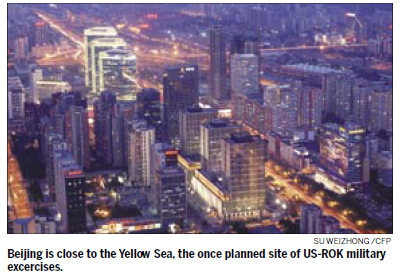 |
Large Medium Small |
News about a US aircraft carrier joining naval exercises on the Yellow Sea, jointly held by the United States and the Republic of Korea (ROK), had unnerved many in China last month.
The latest news, however, said the USS George Washington will not participate in the Yellow Sea exercise, but join the drill on the Sea of Japan/East Sea. For years, US aircraft carriers are a haunting ghost, looming around China. The carrier has long been regarded as a symbol of military, diplomatic and strategic deterrent. For China, US carriers sailing near the Chinese sea are believed to be indecent. In the late 1990s and early this century, these carriers were major tools used by the US to coerce China.
US carriers serve as a barometer of Sino-US relations.How close the carriers are near China's seas and whether China allows the carriers to visit the Hong Kong Special Administrative Region are a reflection of the game between China and the US.
This time, the US decided not to send the USS George Washington to the Yellow Sea because of its tight itinerary and also because China, in a rare practice, lodge several protests.
The wranglings over the Yellow Sea exercise has shown that an "aircraft carrier standoff" has been shaping between Beijing and Washington. In line with the expansion of China's interest of the sea and the modernization of its navy, Beijing urgently needs to build a reliable "security belt" at sea to protect its affluent coastal areas.

To reach this goal, the best way is to break the "forbidden zone", which is under the protection of US carriers. The US, however, continues to implement a "blockage circle", inherited from the Cold War. And to maintain the blockage, carriers are the first choice. From a strategic point of view, the confrontation between China's "security belt" and the American "blockage circle" is inevitable and will accelerate. As the Chinese classic The Art of War has pointed out, the highest form of generalship is to balk the enemy's plans in non-military ways. Thus, to shatter the US blockage, the best way is to resort to diplomatic efforts.
China should first define its areas of core interest, such as the Yellow Sea, which has been dubbed the "gateway to Beijing and Tianjin", "backland of Jiangsu and Shandong provinces" and "Achilles' heel of China's security".
When US aircraft carriers appear on the Yellow Sea, Beijing must let the US know the issue will affect Sino-US relations and add political and diplomatic pressures to the US.
If diplomatic efforts do not work, China can flex its military muscle. But it must be militarily prepared. For example, it should take reconnaissance measures, tracking the US ships and holding military exercises in key sea areas.If the US carriers defy China's protests and sail near Chinese seas, China should take some counter measures.
Excerpts of a comment in The International Herald Leader on July 23